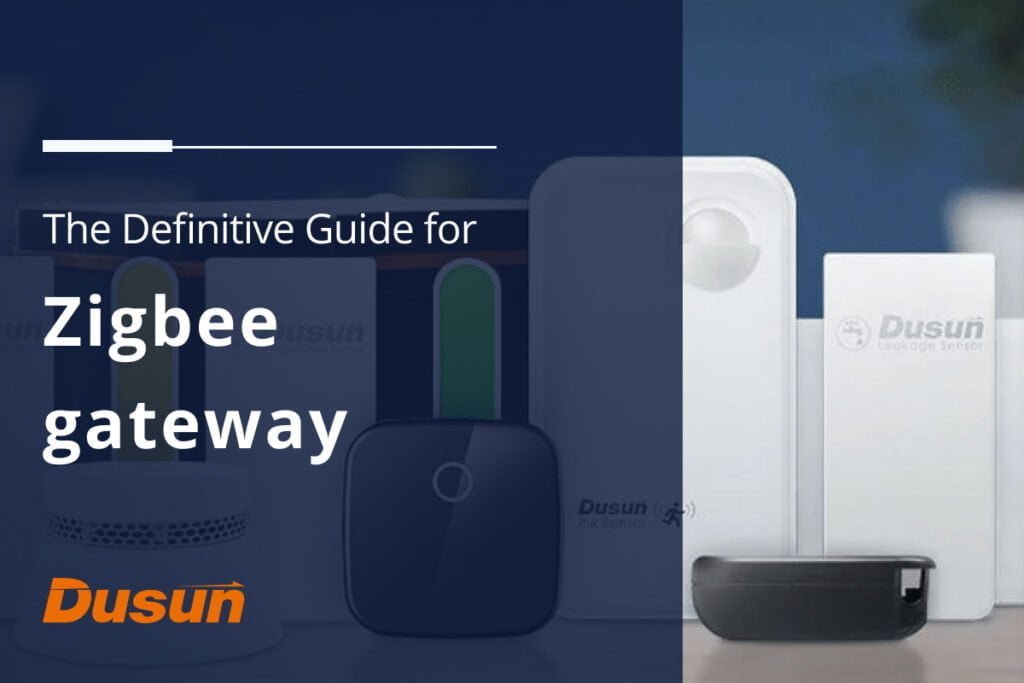What is ZigBee? ZigBee is the core of ZigBee gateway and smart home wireless system. It manages many ZigBee nodes downward, process data and connects upward to the cloud platform, so as to make the smart home system run more reliably. Before we know ZigBee gateway, This article is going to tell you what is ZigBee in IoT and what is ZigBee used for.
The Smart Home, a long-standing promise for more than 30 years, is now becoming a reality. ZigBee has emerged as the preferred wireless communication technology. ZigBee is a low-power wireless technology that works with Wi-Fi to make homes smarter, safer, more comfortable, and more energy efficient.
Explore ZigBee WiFi gateway
The entire goal of a smart home is to have everything connected to everything else. All connected smart home gadgets, in particular, can share information. You can control them all without having to go to each one separately. A single network connects all devices created by various firms. As a result, communication requires a shared language. This is where ZigBee comes in.
What is Zigbee?
Zigbee is a full-stack solution that typically operates following the IEEE 802.15.4 standard and employs wireless mesh network technology. It is a wireless technology based on standards created to enable low-cost, low-power wireless machine-to-machine (M2M) and Internet of things (IoT) networks①.
The ZigBee standard was created by the ZigBee Alliance, which included many significant companies such as Philips, Mitsubishi Electric, Epson, Atmel, Texas Instruments, and others. This Alliance was established as a non-profit organization in 2002.
ZigBee offers IoT hardware and application developers and ends users flexibility as well as excellent compatibility. The protocol has several uses due to its significant features of low cost, low power consumption, and speedier wireless connectivity. For example, it is a preferred technology for smart homes since it outperforms other wireless technologies in several ways.
For starters, ZigBee devices are trustworthy since communication is two-way. Second, it serves all industries, including lighting, security, appliances, and home access. Third, and most significantly, this technology consumes very little power because of its low latency and duty cycle. Furthermore, it employs a mesh network, reducing node failure likelihood.
Zigbee Global Market
Zigbee protocol has been around for many years and it is a market-proven technology. Zigbee has been widely adopted globally across different industries and sectors, due to its promising features. Various renowned organizations have provided authentic research on global trends and the market share of Zigbee. Here I will provide you with some convincing numbers along with their references to prove the value of Zigbee technology.
- Verified market research estimates the ZigBee Market size was valued at USD 3.50 Billion in 2021 and is projected to reach USD 7.79 Billion by 2030, growing at a CAGR of 9.30% from 2023 to 2030.
- According to Reportslinker, ZigBee Market is expected to register a CAGR of over 9.2% during the forecast period (2020 – 2025).
- Market research future says that ZigBee Automation Market is an Estimated net worth of US$ 7.91 billion with a CAGR of 8.60% by the year 2030.
The growth of the market is driven by the increasing adoption of smart homes and connected devices, increasing investment in smart cities, and the need for energy-efficient and low-cost communication solutions.
ZigBee Working Principle
ZigBee is a Personal Area Network technology for home networking, which is created for monitoring and detecting the network. The ZigBee standard, designed by Zigbee Alliance, is based on a standard IEEE 802.15.4. In a standard Zigbee network, IEEE 802.15.4 defines the several layers of the network that are handled by the ZigBee protocol.
ZigBee Frequency Band and License
The physical and MAC layers of IEEE 802.15.4 are used by Zigbee. It operates in the unlicensed 2.4 GHz ISM band as well. Although 2.4 GHz is widely used worldwide, devices in the United States, Europe, and China employ frequencies such as 915 MHz, 868 MHz, and 784 MHz, respectively. Only one channel/frequency band will be selected for use in a network.
- Channel 0: 868 MHz (Europe)
- Channel 1-10: 915 MHz (the US and Australia)
- Channel 11-26: 2.4 GHz (Across the World)
The 2.4 GHz band is the most widely used, as it is unlicensed and available globally. It also transmits data at a rate of 250 kbps②.
ZigBee Communication Range
The range of Zigbee wireless communication can vary depending on factors such as the power output of the devices, the environment in which they are operating, and the specific Zigbee protocol being used. In general, the range of Zigbee devices can be up to around 100 meters (328 feet) indoors and 400 meters (1312 feet) outdoors in the open air, with a maximum theoretical range of around 1,600 meters (1 mile) in ideal conditions. However, the typical range in most of the practical scenarios is between 10-30 meters in indoor environments.
ZigBee Power Requirements
Zigbee devices normally operate on a voltage range of 2.1 to 3.6 volts, with a typical current consumption of around 20-50mA during normal operation. The power consumption of a Zigbee device can also vary depending on the specific Zigbee protocol and frequency being used, as well as the distance between devices and the data rate. For example, Zigbee devices that use the 2.4GHz frequency band will consume more power than those that use the 868/915 MHz frequency band.
Zigbee devices are designed to be low-power and operate on small batteries or other low-power sources, with power ratings typically in the range of a few milliwatts to a few hundred milliwatts. I would recommend you consult the specific datasheet of the Zigbee device for more accurate power and voltage ratings.
ZigBee Architecture
The IEEE 802.15.4 standards for the Physical and MAC layers and its own large network and application layers are followed by the ZigBee network protocol. The architecture of a Zigbee network consists of a combination of 4 layers. The top two layers are defined by the Zigbee alliance ad bottom two layers are based on IEEE standards. The end-user application, which is connected to the wireless link, remains on the top of the 4 network architecture layers. A block diagram and a brief description of each layer are given below for further information.
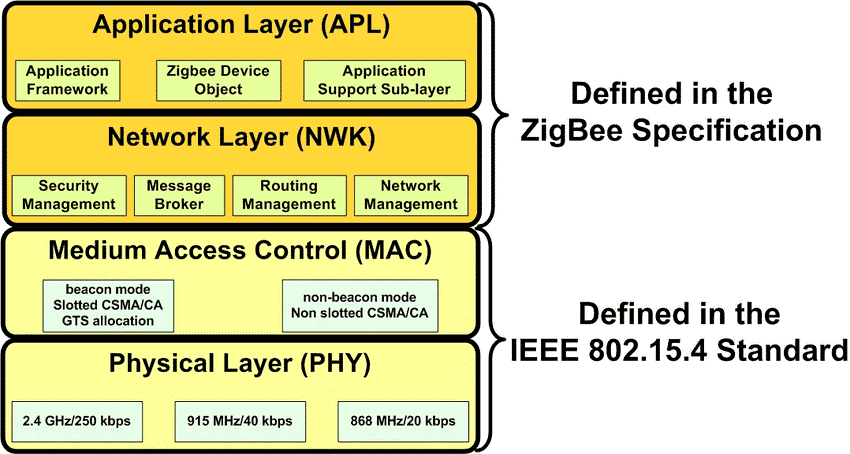
Physical Layer
The physical layer, defined by the IEEE 802.15.4 specifications, directly controls the hardware and is responsible to communicate with the Zigbee transceiver. This layer interprets and transmits the data packets through a wireless communication medium. It also performs the operations of modulation and demodulation while transmitting and receiving the signals. The design and implementation of the physical layer define the frequency band, data rate, range, and other critical parameters.
Medium Access Control Layer (MAC layer)
The layer is also defined by the IEEE 802.15.4 specifications standard. It formulates the interface between the physical layer and the network layer. The MAC layer provides PAN ID and also network discovery through beacon requests.
Network Layer
This layer performs as a communication interface between the MAC layer and the application layer. Here we define the networking topology as mesh networking.
Application Layer
The topmost layer in the Zigbee network protocol is the application layer. It is comprised of the application support layer as a sub-layer and Zigbee devices. It also contains applications designed by different manufacturers.
Zigbee Network Topologies
The Zigbee connectivity protocol uses the standard 802.15.4 physical wireless design that gained board ratification by the Institute of Electrical and Electronics Engineers (IEEE) in 2003. The specification standard is a packet-based wireless protocol envisioned for battery-operated low-cost innovative products with several years of battery life. The Zigbee protocol communicates the devices to transmit the data in a diverse type of network topologies. You can connect your smart home devices using Zigbee protocol devices in several kinds of networks as shown.
ZigBee Star Topology
The start topology, also known as ZigBee Smart Energy, consists of a Zigbee coordinator and several end-user devices. The devices communicate only with the coordinator.
ZigBee Mesh Topology
The mesh topology, also known as Self-Healing Process, consists of a Zigbee coordinator, multiple routers, and end-user devices. Each node is linked to every other node separately through a dedicated cable link, thus forming a mesh in the network. For n nodes, you must have n (n-1)/2 number of links. Due to this large number of link requirements, the mesh topology is considered to be very expensive as its cabling cost is very high.
ZigBee Tree Topology
In the tree topology, the nodes are structured in the form of a tree. Zigbee network consists of a central node which is a coordinator, several routers, and end devices. The main purpose of this topology is to enhance the network’s coverage range. Tree topology comprises one base node and multiple branch nodes.
The branching cable starts from the base node and it connects the base device node with other devices of your smart home network in a sequential or hierarchical style. This topology is economical as compared to the mesh topology.
ZigBee Channel Access
As defined previously that the Zigbee protocol consists of several channels, so there must be some mechanism to access these channels. There are two methods of channel access as described below.
Contention-based method
The methodology contains carrier-sense multiple access with a collision avoidance mechanism. This method is fast as the device doesn’t have to wait for its turn but there could be collision among multiple access requests.
Contention-Free Method
The Zigbee coordinator dedicates a specific time slot to each device in this methodology. Its advantage is the guaranteed time slot, but it could be slow.
Zigbee Security
Wireless technologies are mainly divided into four types: Bluetooth, WiFi, Zwave, and ZigBee. No technology is entirely immune to attack, and ZigBee is relatively secure in a small range of wireless technologies. All Zigbee devices use built-in encryption to prevent hacking.
The Connectivity Standards Alliance, an organization that develops standards for Zigbee technology, uses a certification program to ensure that manufacturers comply with these security standards.
Zigbee Variants
Broadly there are two variants of Zigbee, including Zigbee 3.0 (the latest) and Zigbee Pro. However, there are a few other variants that are designed for specific domains/applications including Zigbee Green Power, Zigbee Smart Energy, Zigbee Light Link, and Zigbee Home Automation. Each variant has its unique features and capabilities, but all of them are designed to work together in a Zigbee network. Zigbee 3.0, the latest variant, is intended to provide a common standard for devices from different manufacturers to work together seamlessly, making it easier for consumers to create and control smart home networks.
Zigbee 3.0
Zigbee 3.0 is the latest version of Zigbee, the wireless communication standard for IoT devices. It is designed to provide enhanced features and capabilities compared to previous versions of Zigbee. Some of the key features of Zigbee 3.0 are given below.
- Interoperability across different device types and vendors
- Improved security features such as encryption and authentication
- Increased network scalability with support for more devices
- Optimized for low-power consumption
- Improved network performance and reliability
Zigbee Pro
Zigbee Pro is designed for use in commercial and industrial applications. It provides features such as larger network capacity, longer battery life, enhanced security, advanced networking, and easy device commissioning.
It is designed to provide a robust, scalable, and secure wireless communication solution for commercial and industrial applications such as building automation, industrial control systems, and smart energy management.
Zigbee Green Power
Zigbee Green Power (ZGP) is a specialized version of Zigbee that is optimized for low power consumption and battery-powered devices and has features that allow for energy-efficient communication and security in a network of devices.
Some of its key features are mentioned below.
- ZGP uses a unique communication method called “Green Power Tunneling” that enables devices to communicate with each other without the need for a central hub or coordinator. This reduces power consumption and extends the battery life of devices.
- Zigbee Green Power devices consume less energy by implementing several power-saving features such as sleep modes, reduced wireless transmission activity, reduced data rate, power-efficient design, and power harvesting.
- ZGP uses the Zigbee Pro stack which is more robust than the Zigbee Home Automation stack, which allows for larger networks and more devices and also has better security features.
Zigbee Smart Energy
Zigbee Smart Energy (ZSE) is a specialized version of Zigbee that has the following distinct features.
- ZSE is specifically designed for use in energy management applications, such as smart meters, load control, and advanced metering infrastructure (AMI).
- ZSE uses the Zigbee Smart Energy Application Profile (SEP) which defines the communication protocols and data models used by devices in the network. This allows for different types of energy management devices to work together seamlessly.
- ZSE includes features such as automatic meter reading (AMR), remote disconnect/reconnect, and demand response, which are useful for managing energy usage and costs.
- ZSE also includes advanced security features such as Advanced Encryption Standard (AES) encryption, secure key establishment, and secure over-the-air (OTA) upgrade to protect the network and the devices connected to it.
Zigbee Light Link
Zigbee Light Link (ZLL) is a specialized version of Zigbee that is optimized for lighting applications. It has the following special features.
- ZLL is specifically designed for lighting applications and has features that make it well-suited for controlling lights, such as colour and intensity control.
- ZLL uses a simpler network setup process called “touchlink commissioning,” which allows devices to be easily added to the network without the need for a central hub or coordinator.
- ZLL also has a “light linking” feature that allows lights to be grouped and controlled together, making it easy to create scenes and automate lighting in a smart home or building.
- ZLL is also backwards-compatible with other Zigbee devices, allowing it to work with other Zigbee-based products and ecosystems.
Zigbee Home Automation
Zigbee Home Automation (ZHA) is a more general-purpose version of Zigbee that is designed for use in a wide range of home automation applications and has features that allow for more complex network topologies and a wider range of devices to be integrated into a single system. Key features of ZHA are:
- ZHA uses the Zigbee Application Profiles (ZAPs) which allows for different types of devices to work together seamlessly.
- ZHA uses the Zigbee Home Automation stack which is less robust than the Zigbee Pro stack but is more power efficient, which is good for battery-powered devices.
ZigBee Technology Summary
For a better understanding and clear picture, the following table will provide you with a summary of all the technicalities discussed above.
| Characteristic | Description |
| Frequency | 2.4GHz, 868/915 MHz, and other frequencies depending on the region |
| Data rate | 20 kbps to 250 kbps |
| Range | 10 to 100 meters |
| Network topology | Mesh network, where each device can act as a router to extend the network range |
| Security | AES-128 encryption for secure communication |
| Power consumption | Low-power, designed to operate on small batteries or other low-power sources |
| Interoperability | Interoperable with other Zigbee devices, regardless of the manufacturer |
| Standard | Open standard, not tied to any specific vendor or product. |
Zigbee vs WiFi vs Bluetooth vs LoRaWAN vs Z-wave
Zigbee and other wireless protocols, such as Wi-Fi, Bluetooth, Z-Wave, and LoRaWAN, have some similarities and some key differences. I have formulated the following table of comparison of some of the main features of each protocol: You can get further insights here.
| Feature | ZigBee | Wi-Fi | Bluetooth | Z-Wave | LoRaWAN |
| Frequency band | 2.4 GHz | 2.4 GHz and 5 GHz | 2.4 GHz | 908.42 MHz | 868 MHz (Europe) / 915 MHz (North America) |
| Range | 30-100 m | 30-100 m | 10-30 m | 30-100 m | 5-15 km (rural) / 1-2 km (urban) |
| Maximum devices | 65,000 | 254 | 7-8 | 232 | thousands (depending on network design) |
| Power consumption | Low | Moderate | Low | Low | Low |
| Security | AES-128 | WPA2-AES | AES-128 | AES-128 | AES-128 / AES-256 |
| Application | IoT devices | Internet and multimedia | Personal device connectivity | Home automation | IoT devices, asset tracking, and machine-to-machine communication |
| Network topology | Mesh | Star | Piconet | Mesh | Star (with gateway) |
| Data rate | 40-250 kbps | 600 Mbps to 3 Gbps | 1 Mbps | 100 kbps | 0.3 kbps to 50 kbps |
| Protocol stack | IEEE 802.15.4 | IEEE 802.11 | Bluetooth 4.2 | ITU G.9959 | LoRaWAN |
Zigbee is compared to other technologies such as Wi-Fi, Bluetooth, and Z-Wave, but each one of them has its advantages and limitations. While Zigbee is less powerful in terms of data rate and range when compared to Wi-Fi and Bluetooth, it is more efficient in power consumption and better suited for battery-powered devices, and it is more open and cheaper than Z-wave. Figure 4 will give you a clear comparison picture in terms of range, cost, data rate and power consumption.
Explore more at Which One is The Best for Smart Home
Advantages of ZigBee
Globally Adopted
Extensive library of mobile apps and devices used by hundreds of businesses worldwide.
Interoperable
There is a large ecosystem of Zigbee products to choose from that work in unison.
Reliable and Low-Power
A self-healing mesh network eliminates single points of failure while consuming little power.
Secure and Reliable
Secure by design, with a variety of security mechanisms, including AES-128-CCM encryption over the air to meet your security requirements.
Who Uses Zigbee?
Residential and Commercial Users
Zigbee is a mature, market-proven technology that provides flexibility and interoperability for smart home and business applications. It is a dependable, secure, energy-efficient, and cost-effective solution with a scalable network size that addresses a variety of Zigbee use cases.
The continuous development of Zigbee is supported by some of the world’s largest utilities, energy service providers, product manufacturers, and technology businesses. Zigbee is still evolving as a technology, with new features in the works and scheduled for release.
IoT Hardware Developers
Zigbee is a mature, market-proven technology with millions of smart devices in IoT use today. Zigbee is the only full-stack interoperability technology supported by a worldwide member ecosystem ranging from silicon vendors to integration services, allowing for IoT development and go-to-market flexibility while maintaining the security of supply chain variety.
IoT Service Providers / Ecosystems
The continuous development of Zigbee is supported by some of the world’s largest utilities, energy service providers, product manufacturers, and technology businesses. Zigbee is a mature, market-proven technology with millions of devices in use today. It is an open standard that allows for a competitive marketplace of various vendors, lowering costs.
The global 2.4GHz (and soon-to-be-released Sub-GHz) spectrum, standard technology, and proven compatibility make adoption and customer service more accessible.
IoT Utilities
The continuous development of Zigbee is supported by some of the world’s largest utilities, energy service providers, product manufacturers, and technology businesses. Zigbee is an open standard that allows for a competitive marketplace with various vendors, lowering costs. The global 2.4GHz (and soon-to-be-released Sub-GHz) spectrum, standard technology, and proven compatibility make adoption and customer service more accessible.
What Devices Use ZigBee?
The ZigBee Alliance is a group of businesses that have adopted this standard. More than 400 members are registered in the Alliance, and over 2,500 devices are in use. Here are some users of this standard:
- Amazon Echo Plus
- Samsung SmartThings
- Apple
- Comcast
- Honeywell
- Philips
- Bosch
- Nokia
Zigbee Examples and Use Cases
Sensor networks based on Zigbee technology are widely used and can help better achieve goals. Zigbee technology applications include smart homes, industrial control, automatic meter reading, medical monitoring, sensor network applications, telecommunication applications, and warehousing logistics systems.
Smart Home
Under normal circumstances, there will be many electrical and electronic devices in the home, such as lights, televisions, refrigerators, washing machines, computers, air conditioners, etc., and there may be smoke sensors, alarms, cameras, and other equipment. In the past, it was possible to achieve point-to-point control, but if ZigBee technology is used, these electronic devices can be linked to form a network.
It can even be connected to the Internet through Smart home ZigBee hub. So people can quickly check on their homes from anywhere without having to run wires. Applying ZigBee wireless communication technology to the field of smart home devices can improve the convenience of operation and reduce the cost of a home on the one hand.
In addition, ZigBee wireless communication technology can also achieve practical signal anti-interference functions, reducing signal interference to other users while creating convenience for people.

Smart Elderly Care
Zigbee can also be widely used in the field of smart elderly care. The IoT elderly home care solutions allow the elderly to remain at home independently for longer. It can detect the elderly’s life trajectory and also protect the elderly’s safety. The system employs inconspicuous wireless sensors placed throughout the home to learn the elderly’s daily behavior patterns and detect behavioral changes that may cause concern.
It then sends messages to family members or caregivers to remind them. The smart elderly care system has been successfully tested in residential care facilities for several years and is now available for home installations by service providers, retailers, and smart home system integrators.

Smart Apartment
Designed to provide renters with a lifestyle blend home and increase rent for tenants, save energy and collect valuable resident population data in return. Smart apartment solutions are mainly for channel dealers and apartment managers. It is equipped with intelligent hardware devices such as zigbee gateway hub, access control, locks, thermostats, smart meters, liquid leakage sensors, human motion sensors, smart sockets, and smart switches.
At present, the smart home apartment solutions on the market mainly adopt cloud-to-cloud docking solutions. Assuming a problem with the equipment service provider will cause the cloud platform to stop serving, making the apartment system unable to operate normally and causing losses.
Dusun IoT can provide a way for devices to directly connect to the apartment system, avoiding the risk of system crashes caused by third-party problems in apartment system services. Most importantly, Dusun IoT provides a standard device docking API, allowing the system docking time to be controlled within one month. This is something that most solution providers cannot do.

Medical Monitoring
Electronic medical monitoring is a recent research hotspot. Many sensors are put on a person’s body to measure things like pulse, blood pressure, and health status. Monitors and alarms are also placed in a hospital ward so that physical conditions can be checked at any time. Once a problem occurs, you can respond in time, such as by notifying the duty staff of the hospital.
Through ZigBee technology, these sensors, monitors, and alarms may connect to create a monitoring network. Because it is a wireless technology, there is no need for a wired connection between sensors, and the person being monitored can move freely.
Sensor Network Application
The sensor network is also a recent research hotspot and has good application prospects in aspects such as cargo tracking, building monitoring, and environmental protection. Low-cost nodes, low power consumption, automatic networking, simple maintenance, and high reliability are requirements for sensor networks.
ZigBee is a great technical option for sensor network applications because of its benefits in networking and low power usage.
Warehousing Logistics System
With the promotion of warehousing and logistics systems, the demand for unlimited data transmission systems has shown a rising trend. It puts forward high-efficiency and low-cost requirements for wireless communication technology. ZigBee is especially suitable for warehousing and logistics systems due to its safety and reliability, multi-path routing, and other characteristics. Its practice is embodied in:
First is the scheduling of on-site vehicles. Because the connection between the vehicle and the console is so important and because it’s hard to ensure the transmission distance with traditional wireless communication protocols in places like warehouses and logistics, ZigBee can be used to solve this part of the problem.
Second, the network structure of meshed ZigBee wireless communication technology can be applied to warehousing and logistics, relying on data relay, dynamic routing, and other means to ensure the reliability and efficiency of overall system communication.
Third, vehicles in warehousing and logistics always have to move constantly, and conventional wireless communication protocols always show the problem of insufficient flexibility when finding the best path. The application of technology, with its network topology, can meet the changing needs of information transmission paths and can flexibly provide an ideal transmission path to ensure the quality of communication.

Automatic Meter Reading
Sensors convert the meter readings into digital signals that send the readings directly to the company that supplies the gas or water via the ZigBee network. Using ZigBee for meter readings can also bring other benefits. For example, the gas or water company can send some information directly to the user or combine it with energy savings. It can automatically reduce the speed of use when it finds that the energy is being used too fast.
Wireless ZigBee Devices
The Internet of Things market has more and more product types and more and more mature technologies. With the continuous improvement of ZigBee technology, it will become the most cutting-edge digital wireless technology in the world today. The significant advantages of ZigBee, such as low power consumption, low cost, low speed, and convenient use, make it bound to have broad application prospects.

Thermostats, energy meters, temperature, presence, brightness, and CO2 sensors, smart sockets, actuators with integrated energy and power meters: a diverse range of wireless devices for Smart Building projects aimed at maximizing energy efficiency.
Zigbee Gateway
ZigBee gateway is an IoT gateway acts as a bridge between a ZigBee network and other wireless or wired network such as Wi-Fi or Ethernet. ZigBee bridge hub gateway allows ZigBee devices (such as smart lighting, thermostats, and security cameras) on the ZigBee mesh network to communicate with devices on the other network, and vice versa. Users can use smartphones to monitor their ZigBee devices. Within the ZigBee gateway, there is a ZigBee coordinator which manages the ZigBee network, and another network interface connecting ZigBee network to the other network, mainly depends on your choice.
All IoT gateways of Dusun support Zigbee, including Programmable IoT Gateway, Cloud Platform Gateway, IoT App Gateways.
The ZigBee hub gateway, independently developed by Dusun IoT, supports the access of mainstream ZigBee protocol version terminal devices and allows third-party terminals that conform to the standard ZigBee protocol to access multi-service support expansion.
Smart Plugs/Sockets
The Wi-Fi & Zigbee-enabled socket works with Alexa to make any outlet be voice control. Multi-function supported: remote control, timer, and schedule lights, lamps, and small appliances to turn on/off automatically.
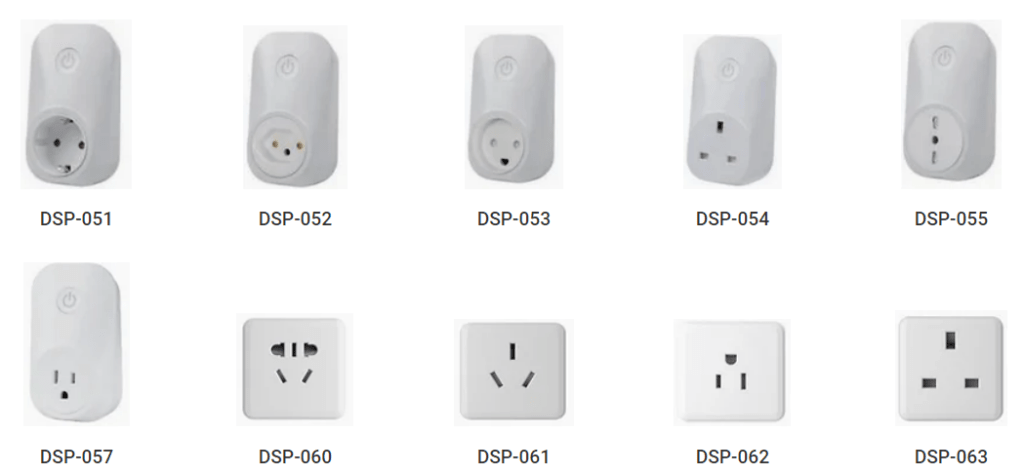
Sensors
Through our IoT center, Zigbee-certified sensors may be quickly incorporated into the customer’s platform.
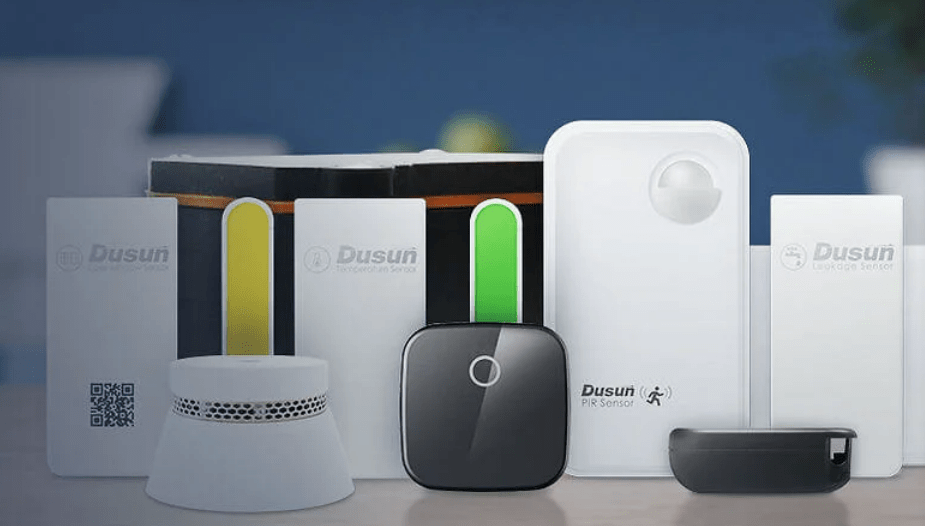
Wireless Module
embedded Zigbee3.0 modules are also provided, allowing users to develop Zigbee gateways that meet individual needs. In the future, more and more smart products with ZigBee functions will enter our life, bringing great convenience and speed to our life and work.
Smart Switch
Smart switch is used for wireless wired devices. based on the wireless protocol Zigbee and Bluetooth wireless. Additionally, it can be utilized for wireless control of things like a garden door, garage door, access system, and intercom.

Wifi Router
The maximum Wi-Fi data rate is 580Mbps, while the maximum BLE data rate is 2Mbps. Additionally, the Wifi Router is capable of supporting the 5V adaptor and POE switch power supplies. Both the ZigBee3.0 and 4G LTE functions are reserved. The series contains two versions, dual-band 4G LTE router and router gateway. Dusun also offers Tuya-compatible routers ndeveloped in the base version.
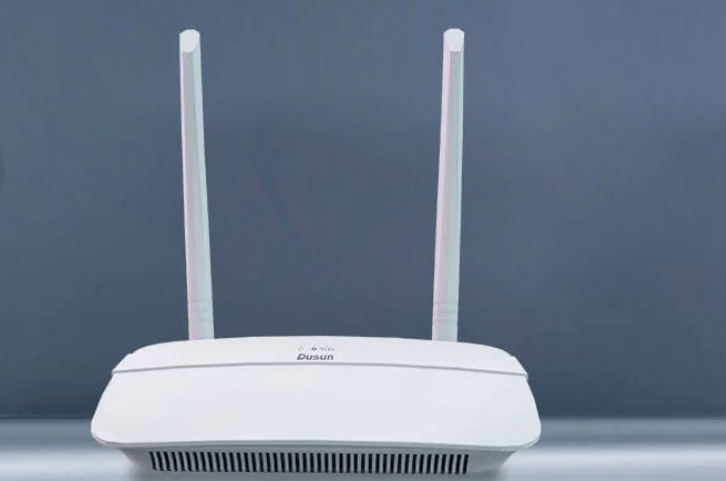
ZigBee Compatibility
Zigbee-certified devices connect using the standard IoT protocol with each other. It helps to add millions of already developed Zigbee smart products to smart commercial and home buildings. The compatibility of Zigbee increases flexibility for users and designers to mix and match multiple Zigbee products from various vendors. It also brings confidence to you that products and services will work together through standardization and testing of all layers of the stack.
ZigBee Installation
If you are convinced to go smart with Zigbee protocol, then you must go through this section to get key insights regarding the installation details. I will guide you on how you can transform your ordinary home or workplace into a smart arena.
ZigBee Hardware You Need
To create your own smart Zigbee network, you’ll need the following types of devices:
Universal ZigBee gateway: This device acts as the central controller for the network and is responsible for managing the network and coordinating communication between devices.
ZigBee routers: These devices act as intermediaries between the coordinator and end devices, forwarding data and maintaining network connectivity.
ZigBee end devices: These are devices that perform specific functions, such as sensing or controlling, and communicate with the network through a router like light bulbs, motion sensors, energy meters, etc.
ZigBee Installation Guide
The installation process needs to follow vendor-specific instructions, as the installation process may vary depending on the manufacturer and model. However, installation of the Zibgee network typically involves the following steps:
Obtain the necessary devices
This includes the Zigbee devices (such as sensors, switches, and controllers), a Zigbee hub or gateway (if required), and any additional accessories such as power adapters and batteries
Prepare the installation site
This includes selecting the location for the devices and ensuring that they have a clear line of sight to the hub or gateway. It’s also important to check that the devices are within range of the hub or gateway.
Install the ZigBee devices
This includes physically installing the devices in the desired location, connecting them to power, and configuring them as required.
Pair the devices with the ZigBee gateway hub
This typically involves using a smartphone app or web interface to connect the devices to the hub or gateway.
Configure the ZigBee network
This includes setting up the network parameters such as channel and network ID
Test the ZigBee network
Verify that all the devices are working properly and communicating with the hub or gateway.
It’s worth noting that Zigbee devices usually require a ZigBee hub gateway to connect to the internet or other devices, and these hubs or gateways will require a power source and internet connection. Here is a sample example of developing an application communicating with ZigBee devices on Dusun gateways.
ZigBee Gateway FAQs
Do I need a zigbee gateway?
To be controlled, ZigBee devices require a ZigBee gateway. The Zigbee protocol is not currently supported by mobile phones. so you need a Zigbee gateway to translate the Zigbee protocol into the Wi-Fi protocol so that you may control your Zigbee devices with your smartphone. A ZigBee gateway also centrally maintains ZigBee devices and makes sure they are secure and operating properly. A ZigBee gateway may also connect to these Zigbee gadgets even if the network is down. It is preferable to utilize the standard ZigBee protocol or devices that accept the standard ZigBee protocol in order to prevent the normal operation of devices from different manufacturers because different brands of Zigbee devices will create their own proprietary Zigbee protocols.
What is the difference, zigbee hub vs gateway?
The word “hub” has a fairly broad definition and can refer to anything, even a straightforward protocol hub. They fall into one of three categories: hardware-only hubs, software-only hubs, or hardware and softwarehubs that combine both types.
If you want to find a ZigBee Hub that can connects networks of different network type together, such as Zwave to TCP/IP, then you are looking for a hardware-ony ZigBee hub. The key characteristics you should watch out for are:
- Multiple protocols are supported, including Bluetooth, Z-wave, Wi-Fi, and LoRaWAN.
- Use of OpenWRT, Ubuntu, Debian, Android, etc. for control.
- Use of IFTTT rules (If This Then That).
- MQTT assistance.
- IP support is required to connect the cloud.
- Security
If you want to find a ZigBee hub that allows you to control smart home gadgets via a home automation software like Home Assistant, then you are look for software-only hub. All of your smart home gadgets will be integrated into a single, seamless experience with the help of home automation software. Consider the free and open-source platform Home Assistant, which emphasizes local autonomy and privacy while acting as a central control system for smart home gadgets. It can be accessed by voice commands using a supported virtual assistant like Google Assistant or Amazon Alexa, a web-based user interface, or companion apps for Android and iOS. Integration hubs are a subset of ZigBee hubs.
Typically, software needs hardware to act out its instructions, but hardware likewise needs software to inform it what to do. A ZigBee hub can also be a ZigBee gateway coupled with home automation software, which makes sense in terms of ZigBee hub usage because you can do all kinds of things when you mix the two. This is the so-called hardware and software hub.
LoRaWAN vs Zigbee: which one to choose for better connectivity?
When it comes to range and power usage, LoRaWAN beats out Zigbee. ZigBee is preferred for indoor environments and short-range communication. It is clear that usage will determine which wireless technology is best to use for IoT connectivity.
Smart water meter reading, smart agriculture, smart parking lots, vehicle monitoring, personnel position tracking, smart communities, and others are typical LoRaWAN applications.
While Zigbee is utilized for remote monitoring and control, it has a long history in the industrial sector. The efficiency and interoperability of IoT devices will be significantly increased by the Zigbee mesh network solution.
Reference
Zigbee (2022) Wikipedia. Wikimedia Foundation. Available at: https://en.wikipedia.org/wiki/Zigbee
Zigbee protocol (no date) Zigbee Protocol – an overview | ScienceDirect Topics. Available at: https://www.sciencedirect.com/topics/engineering/zigbee-protocol
Zigbee market size, share, trends, growth, Opportunities & Forecast (2022) Verified Market Research. Available at: https://www.verifiedmarketresearch.com/product/global-zigbee-market-size-and-forecast-to-2025/
You May Also Interested in These ZigBee-related Articles









